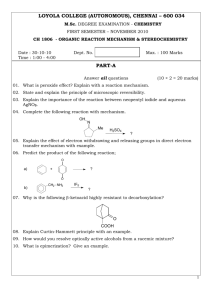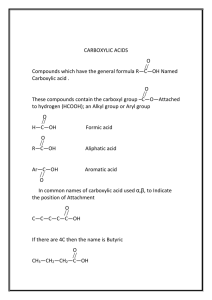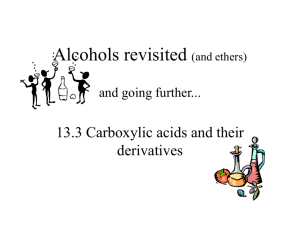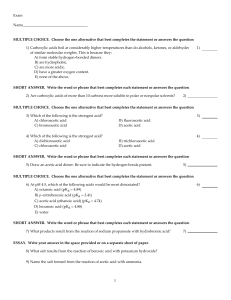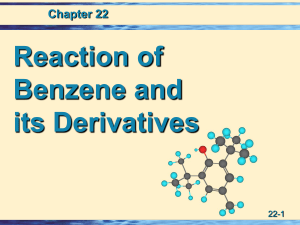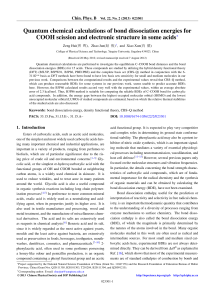Carboxylic Acids: Acidity, Salts, Spectroscopy, Synthesis
advertisement
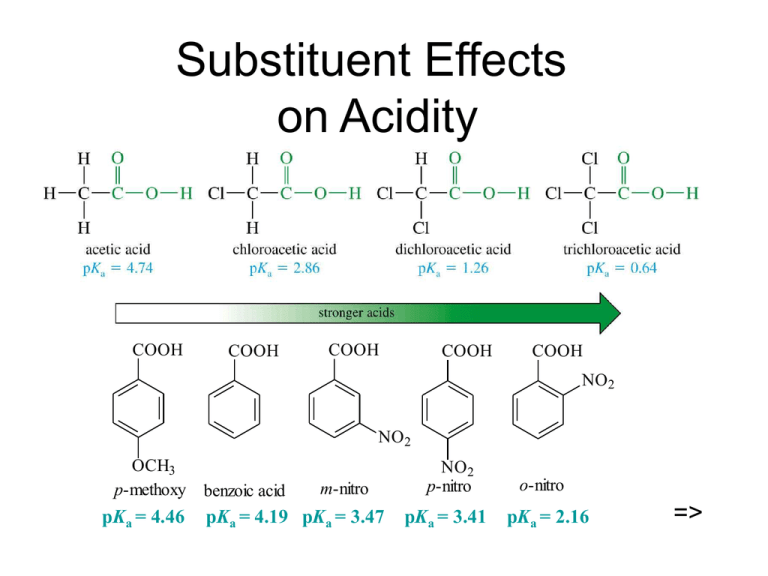
Substituent Effects on Acidity COOH COOH COOH COOH COOH NO2 NO2 OCH3 p-methoxy pKa = 4.46 benzoic acid m-nitro pKa = 4.19 pKa = 3.47 NO2 p-nitro pKa = 3.41 o-nitro pKa = 2.16 => Salts of Carboxylic Acids Sodium hydroxide removes a proton to form the salt. Adding a strong acid, like HCl, regenerates the carboxylic acid. O CH3 C OH NaOH O CH3 _ + C O Na HCl => Naming Acid Salts Name the cation. Then name the anion by replacing the -ic acid with -ate. Cl - CH3CH2CHCH2COO K + potassium -chlorovalerate potassium 3-chloropentanoate => Properties of Acid Salts Usually solids with no odor. Carboxylate salts of Na+, K+, Li+, and NH4+ are soluble in water. Soap is the soluble sodium salt of a long chain fatty acid. Salts can be formed by the reaction of an acid with NaHCO3, releasing CO2. => Purifying an Acid Some Important Acids Acetic acid is in vinegar and other foods, used industrially as solvent, catalyst, and reagent for synthesis. Fatty acids from fats and oils. Benzoic acid in drugs, preservatives. Adipic acid used to make nylon 66. Phthalic acid used to make polyesters. => IR Spectroscopy => NMR Spectroscopy => UV Spectroscopy Saturated carboxylic acids absorb very weakly around 200-215 nm. If C=C is conjugated with C=O, molar absorptivity = 10,000 at 200 nm. An additional conjugated double bond increases the absorption wavelength to 250 nm. => Mass Spectrometry => Synthesis Review Oxidation of primary alcohols and aldehydes with chromic acid. Cleavage of an alkene with hot KMnO4 produces a carboxylic acid if there is a hydrogen on the double-bonded carbon. Alkyl benzene oxidized to benzoic acid by hot KMnO4 or hot chromic acid. => Grignard Synthesis Grignard reagent + CO2 yields a carboxylate salt. CH3 CH3 CH3CH3CHCH2MgBr O C O + - + CH3CH3CHCH2COO MgBr H CH3 CH3CH3CHCH2COOH =>
